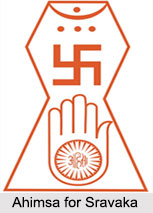 Concept of Ahimsa for Sravaka is that by minimizing the violence. The Sravaka try to follow non-violence to maximum possible way. The ethical code for Sravaka is with some concessions. Concessions given to the Sravaka is by taking 5 Anuvrata as they are partial or limited vows and they are not to be followed absolutely like an ascetic. For a lay-follower it is not possible to survive without committing violence, but it is possible to minimize violence. Utmost carefulness is required in doing the activities so that violence can be avoided. The 12 Vratas are suggested to Sravakas to minimize physical violence.
Concept of Ahimsa for Sravaka is that by minimizing the violence. The Sravaka try to follow non-violence to maximum possible way. The ethical code for Sravaka is with some concessions. Concessions given to the Sravaka is by taking 5 Anuvrata as they are partial or limited vows and they are not to be followed absolutely like an ascetic. For a lay-follower it is not possible to survive without committing violence, but it is possible to minimize violence. Utmost carefulness is required in doing the activities so that violence can be avoided. The 12 Vratas are suggested to Sravakas to minimize physical violence.
Classification of Living Beings in Jainism
One of the classification of different living beings given in Jainism is based on number of senses that the organism has. The different life forms are one sensed, two sensed, three sensed, four sensed and five sensed living beings. Different embodied Jivas have different karmas and depending upon their karmas, they are at different stages of evolution having different life forms. Depending upon the life form, the living beings have the number of senses. The difference in the one sensed and five sensed beings is that latter have more number of Prana, are more evolved and may be with or without mind.
Anuvrata of Ahimsa for Sravaka
The Sravaka has to avoid the intentional injury to all the living beings, also avoiding injury to mobile beings having two to live senses. The ethical code laid down for the Jains has given maximum importance to the observance of the Ahimsa Vrata, i.e., the vow of Ahimsa. This vrata puts into practice the principle of avoidance of Himsa in actual life. Ahimsa has been treated as the first of the five Mahavratas.
The Jain scriptures, allowed the Sravakas and the Sravikas to observe the Ahimsa Vrata as an Anuvrata. As such, the householders were required to observe the Ahimsa Vrata with comparatively less severity but at the same time without transgressing the basic tenets of Ahimsa. Thus, it is necessary for the householders to put a number of restrictions on their economic, social, cultural and other activities connected with their livelihood and maintenance.
Types of Violence for Sravaka
The Himsa can be committed by three kinds of Yoga, i.e., modes or means viz., of mind, speech and body. In other words, injurious activity can be committed. The different types of Violence among the Sravakas are as follows:
1. Samkalpi Himsa (Intentional Violence) - Violence for the sake of violence.
2. Arambhi (Accidental) - Violence in Accidental or Incidental acts
3. Udyogi (Occupational) - Violence involved in Occupation or Vocation
4. Virodhi (Protective) - Violence involved in Self-defense or Protection




















